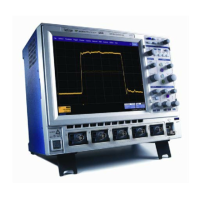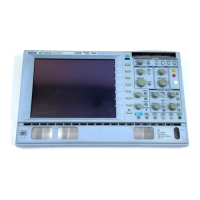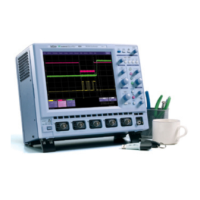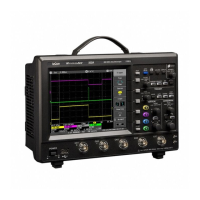WAVERUNNER XI SERIES
72 WRXi-OM-E Rev C
3. Touch inside the Grid Intensity field and enter a value from 0 to 100 using the pop-up keypad.
4. Touch the Grid on Top checkbox if you want to superimpose the grid over the waveform. Depen
grid intensity, some of your waveform may be hidden from view when the grid is placed on top. To undo,
ding on the
simply uncheck Grid on Top.
5. Touch the Axis Labels checkbox to permanently display the values of the top and bottom grid lines
(calculated from volts/div) and the extreme left and right grid lines (calculated from the timebase).
6. Choose a line style for your trace: solid Line or Points:
Sequence Mode Display
To a set up Sequence Mode display, you must first have selected Sequence trigger mode in the Timebase
dialog. You must also have entered a Num Segments value. Persistence must be turned off.
1. In the menu bar, touch Display; then touch Display Setup… in the drop-down menu.
2. If persistence is enabled, turn it off by touching the Persistence tab and un-checking the Persistence On
checkbox.
3. Select a display mode by touching one of the mode buttons.
4. Touch inside the Num seg displayed field and enter a value, using the pop-up keypad. The maximum
number of segments that can be displayed is 100.
5. Touch inside the Starting at field and enter a value.
Note: The maximum value that you can enter for Starting at depends on the Num Segments value you
entered in the Timebase dialog. It also depends on the Num seg displayed value you entered here in the
Display dialog. For example, if you had entered a value of 500 in Num Segments, and a value of 10 in Num
seg displayed, the maximum value you can enter as a starting segment is 491so that 10 segments can be
seen.
P
T for a
r
c " in
intensitie me color, or graded in a spectrum of colors.
e for up to eight inputs for any channel, math function, or memory location (M1 to M4).
ersistence Setup
he analog Persistence feature helps you display your waveform and reveal its idiosyncrasies or anomalies
epetitive signal. Use Persistence to accumulate on-screen points from many acquisitions to see your signal
hange over time. The instrument persistence modes show the most frequent signal path "three-dimensionally
s of the sa
You can show persistenc

